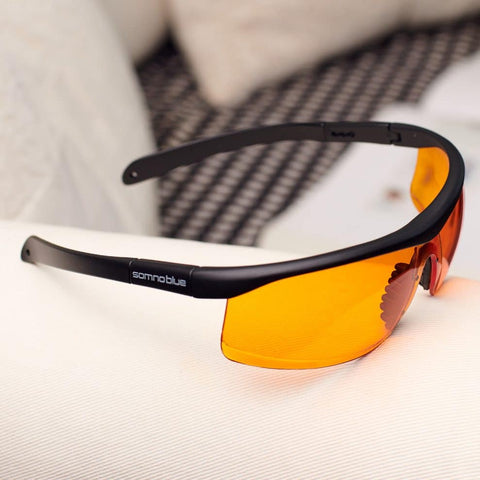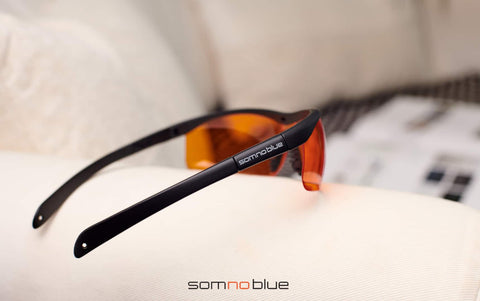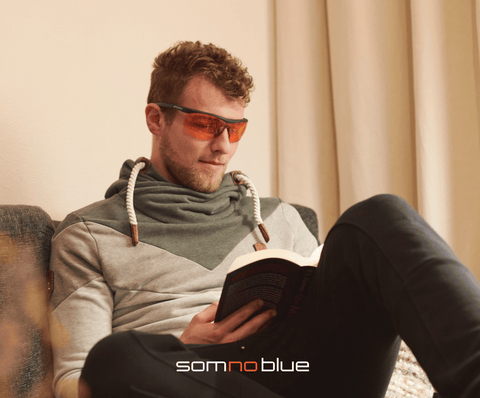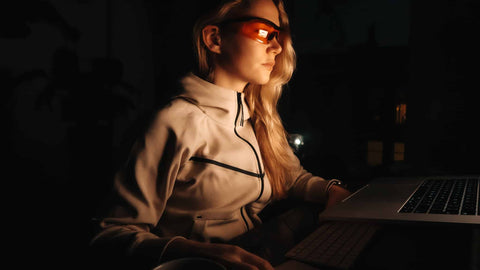Blue light is beneficial if it is natural, but harmful if it is artificial. Our body depends on sunlight and the various colors of nature. It is one of the most necessary elements to maintain our health, along with air and water. Light is made of electromagnetic particles that travel in waves. These waves emit energy and have ranges in length and strength. The shorter the wave, the higher the energy. The length of waves is measured in nanometers (nm), with one nanometer equal to one billionth of a meter. Every wavelength is represented by a different color. Each of them is grouped within the following categories: gamma rays, x-rays, ultraviolet (UV) rays, visible light, infrared light and radio waves. All of these wavelengths make up the electromagnetic spectrum. Blue light has a wavelength of approximately between 380 nm and 500, making it one of the shortest and highest energy.
 Blue light is actually found everywhere. When we are outdoors, sunlight travels through the entire atmosphere. The blue wavelength, the shortest and highest energy , collides with air molecules causing blue light to scatter everywhere. This is what makes the sky look blue. In its natural form, your body uses blue light from the sun to regulate your natural sleep-wake cycles. This is known as the circadian rhythm. When there is no natural light, the night cycle begins for our body, which is regulated by the production of melatonin . This hormone is essential for our body to rest, detoxify and regenerate during the night. Blue light also helps raise alertness , increase reaction times, elevate mood, and increase feelings of well-being. But there is also artificial light that harms us , and that we receive from electronic devices such as: mobile phones, laptops, fluorescent lamps and LED lights.
Blue light is actually found everywhere. When we are outdoors, sunlight travels through the entire atmosphere. The blue wavelength, the shortest and highest energy , collides with air molecules causing blue light to scatter everywhere. This is what makes the sky look blue. In its natural form, your body uses blue light from the sun to regulate your natural sleep-wake cycles. This is known as the circadian rhythm. When there is no natural light, the night cycle begins for our body, which is regulated by the production of melatonin . This hormone is essential for our body to rest, detoxify and regenerate during the night. Blue light also helps raise alertness , increase reaction times, elevate mood, and increase feelings of well-being. But there is also artificial light that harms us , and that we receive from electronic devices such as: mobile phones, laptops, fluorescent lamps and LED lights.
Why should we worry about blue light exposure?
Blue light waves are among the shortest and highest energy waves in the visible light spectrum. Because they are shorter, these “blue” or “High Energy Visible” (HEV) wavelengths flicker more easily than longer and therefore weaker wavelengths. This type of flicker creates a glare that can reduce visual contrast and affect sharpness and clarity. This flickering and glare can be one of the reasons for eye strain, headaches, and mental and physical fatigue caused by sitting for long hours in front of a computer screen or other electronic device. Our eyes' natural filters do not provide sufficient protection against the blue light rays emitted from these electronic devices or fluorescent light tubes. Prolonged exposure to blue light can cause damage to the retina and contribute to age-related macular degeneration , which can lead to vision loss. The relationship between artificial blue light and its relationship with the development of Alzheimer's and senile dementia is also being studied.Where does excess blue light exposure come from?
The evolution in digital display technology has advanced dramatically over the years. Many of today's devices use LED lighting technology to help enhance screen brightness and sharpness. These LED lights emit very strong blue light waves. Mobile phones, computers, tablets and flat screen televisions are just a few devices that use this technology. Because of its widespread use and growing popularity, we are increasingly exposing ourselves to more and more sources of blue light and for longer periods of time.
We use electronic devices excessively
In 2014, two studies were carried out in the USA with children between 12 and 15 years old. Researchers at the US Centers for Disease Control and Prevention found that about 7.5% of them spend at least two hours a day watching television and using a computer . They also found that 15% of teenagers watch television for four or more hours daily, while 12% use their computers for four or more hours per day. Dr. Marjorie Hogan , a pediatrician who helped write the American Academy of Pediatrics' guidelines on children's screen time, acknowledges that parents have a difficult task limiting TV and computers to children at this time. range from 12 to 15 years of age, especially in the digital age.What are the effects of exposure to blue light on our health?
Natural blue light can help elevate our mood and increase our alertness. However, chronic exposure to blue light at night can decrease the production of melatonin, the sleep-regulating hormone, and disrupt our circadian rhythm . Artificial blue light prevents our body from synthesizing melatonin, which affects our rest and nighttime regeneration. Additionally, melatonin is known to be a powerful antioxidant and anti-cancer . If during the last hours of the day we are exposed to artificial blue light, this will delay the production of melatonin in our body for several hours and will be more vulnerable to aging and cancer . Harvard researchers have linked night work and blue light exposure at night to several types of cancer (breast and prostate), diabetes, heart disease, obesity, and an increased risk of depression .Blue light and digital eye strain
Most of us spend most of our waking hours looking at a digital screen, whether it's our computer at work, our cell phone, or watching television. Digital eye strain is a new term used to describe conditions resulting from the use of today's popular electronic devices. Digital eye strain is a medical problem with serious symptoms that can affect learning and productivity at work. Symptoms of digital eye strain, or computer vision syndrome, include blurred vision, difficulty focusing, dry and irritated eyes, headaches, neck pain, and back pain. Digital eye strain has surpassed carpal tunnel syndrome as the number one computer-related illness.Children the most affected
Digital eye strain doesn't just affect adults. Children are also at risk of eye strain due to their increased use of digital devices. Today's children have more digital tools at their disposal than ever before – tablets, smartphones, e-book readers and video games are just a few. According to a study conducted by the Kaiser Family Foundation, children and adolescents (from 8 to 18) spend more than 7 hours a day using electronic equipment. Before the age of 10, children's eyes are not fully developed . The crystalline lens and cornea are still largely transparent and overexposed to light, therefore, too much exposure to blue light is not a good thing. Parents should monitor and limit the amount of time they allow their children to spend in front of a screen. About 70% of adults who regularly use devices experience some symptoms of eye strain , but many do nothing to reduce their discomfort, especially due to lack of knowledge.Blue light and macular degeneration
There is growing medical evidence that exposure to blue light can cause permanent vision damage , contribute to the destruction of cells in the center of the retina, and play some role in age-related macular degeneration that can lead to loss of vision. of vision. Melanin is the substance in the skin, hair and eyes that absorbs harmful ultraviolet rays and blue light rays. It is our body's natural sun protection. Adequate levels of melanin protect us, but as we age we lose melanin, so by the time we are 65 half of the protection has been lost, making us more susceptible to eye diseases such as macular degeneration. The retina is a very thin, many-layered tissue that covers the inner part of the eyeball. The retina can be damaged by the high-energy visible radiation of blue/violet light that penetrates the macular pigment found in the eye. A low density of macular pigment may represent a risk factor for age-related macular degeneration by allowing greater damage from blue light to the retina. A Harvard medical study states that “High Energy Visible (HEV) blue light has been identified for years as the most damaging light to the retina .” "After chronic exposure, one can expect to see a growth in the number of macular degenerations such as glaucomas and retinal degenerative diseases." And in an article published by the American Macular Degeneration Foundation (AMDF) it is reported that “ blue light rays in the spectrum appear to accelerate age-related macular degeneration (AMD) more than any other rays in the spectrum.”Who needs protection from blue light exposure?
We all need to take precautions against the effects of blue light . Whether we work in an office or play in the sun, spend hours staring at a computer screen or scrolling through text messages on our phones, we are all being exposed to blue light.Beneficial effects of Natural blue Light
- It helps regulate the circadian rhythm, the body's natural sleep-wake cycle.
- Increases alertness.
- Helps memory and cognitive function.
- Elevates moods.
Harmful effects of artificial blue light
- Disrupts the circadian rhythm.
- Digital Visual Fatigue Syndrome: blurred vision, difficulty focusing, dry and irritated eyes, headaches, neck and back pain.
- Increased risk of certain types of cancer.
- Increased risk of diabetes, heart disease and obesity.
- Increases the risk of depression.
- May cause permanent vision damage; It can contribute to age-related macular degeneration that can lead to vision loss.
The Vision Council 2012 & 2013 report reported on protective measures against blue light damage.
Reduce screen brightness: Adjust the screen brightness in the settings. Consider changing the background color from white to gray. There are also screen filters, and programs that protect you such as f.lux (for computers) and "Blue Light Filter" (for mobile phones). These applications adapt the screen of your device according to the time of day you are. As it gets darker, a filter is activated, protecting you from harmful blue light from your device. Clean the screen: A dust-free and fingerprint-free screen helps reduce glare. Reduce peripheral lights: Reduce the amount of light that competes with your screen. Dim the light indoors and avoid using your device in broad daylight. Adjust the screen: Regardless of the device, the screen should always be in front of your eyes, and a little below your level. Handheld devices should be at a certain distance from your eyes. Increase the size of the letters: Try to increase the size of the font to better define the content of the screen and to make reading more comfortable for your eyes. Blink more often: Remember to blink more often. Looking at a screen decreases the number of times you blink, and causes the eye to dry out. Take a 20-20-20 break: Every 20 minutes, take a 20-second break and look at a distance of 20 meters. Limit time spent on blue screens: Consider limiting the time you spend using a digital device. Just two hours staring at a digital screen can cause eye strain. Parents should monitor and limit the time their children spend in front of a screen, and reduce the time they themselves spend on their devices to set an example. Install a blue light protector on your computer, tablet and mobile phone: If you want to protect yourself from blue light on your computer, the best alternative that exists is an application called IRIS. This is a program that, in addition to protecting you from blue light, has several other features such as brightness and flickering functions, among others. There is a free version but the paid version is much more complete and is very cheap. If you want to know this application click HERE. Use orange protective glasses: The artificial lights we have in our house also emit blue light. If you want to completely protect yourself from blue light at night, I recommend orange goggles. These are the best glasses, quality and price ratio. Most of the information in this post has been taken from: bluelightexposed.com👇🏼 GET THE GLASSES HERE 👇🏼







Comments (0)
There are no comments for this article. Be the first one to leave a message!